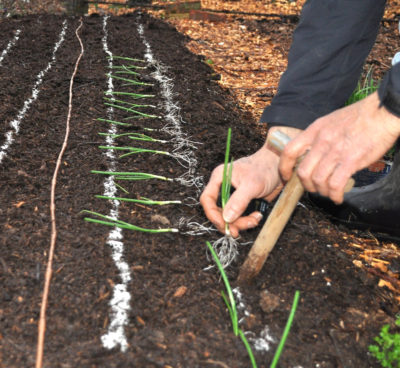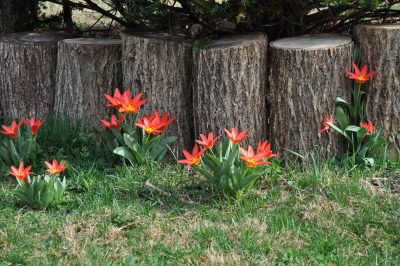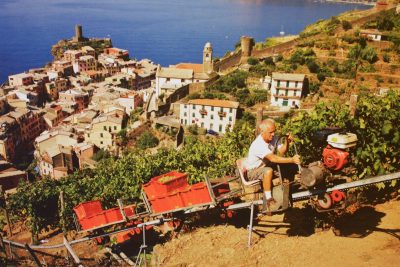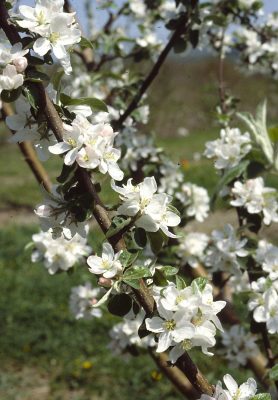Spring?
/11 Comments/in Gardening/by Lee ReichSpring, You’re Late
Seems like everyone — in the northern half of the country east of the Rockies, at least — is talking about this spring’s weather. Robert Frost (in “Two Tramps in Mud Time”) had it right when he wrote:
The sun was warm but the wind was chill.
You know how it is with an April day
When the sun is out and the wind is still,
You’re one month on in the middle of May.
But if you so much as dare to speak,
A cloud comes over the sunlit arch,
A wind comes off a frozen peak,
And you’re two months back in the middle of March.”
Perhaps T. S. Elliot (in “The Waste Land”) was right in writing that “April is the cruelest month.”
But has this past April really been crueler than most? Usually I pooh-pooh day to day impressions. But even Sammy, who usually bounds over to me from his doghouse each morning when he sees me, stayed in and watched as I crossed the yard a couple of weeks ago over ground recently covered with a dusting of snow. 
Phenology, the study of climate as reflected in the natural cycles of plants and animals, is one way to give the weather an objective assessment. For decades, I’ve recorded the dates on which various plants have blossomed. My interest was horticultural: In spring, plants blossom after experiencing a certain accumulation of warm temperatures. So various blossoms can be indicators of when it’s safe to sow seeds or set out plants of various vegetables and flowers.
Depending on late winter and spring weather, blossoming dates for various plants can vary quite a bit. Microclimate also plays a role, so I’ve tried to always note blossoming on the same plant from year to year. Back in 2010, forsythia bloomed about April 1st, the earliest I’ve ever recorded. Contrast that with 2009, when it bloomed about April 15th, or back in 1984, when it bloomed on April 25th!
This year, forsythia bloomed on April 23rd, late again. Over the years, forsythia bloom dates average around the middle of April, so this year is definitely late. All these forsythia bloom dates are for forsythia on my farmden, which is in a local cold pocket so blossoms spread their yellow petals a few days later than plants even just a few miles away.
Another key indicator for me is cornelian cherry (Cornus mas), whose yellow blossoms are most welcome because they frequently open the first day of spring. Not this year though; mine bloomed on April 20th.
Daffodils typically bloom here in early April, although back in 2016, they bloomed on March 25th. This year, April 21st.
One of my favorite blooming shrubs, also producing very tasty fruit, is Nanking cherry (Prunus tomentosa).

Nanking cherry hedge
Stems on the row of them along my driveway typically form a veritable wave of pinkish white blossoms around the middle of April. As I write, it’s April 24th and that wave is just building. If warm weather continues, it should roll in within a few days. (Update: It did, on the 28th.)
Plants Tell Me When To Plant
It’s tradition to plant corn when “oak leaves are the size of mouse ears.” Considering phenology, I take timing one step further, planting, for example, lettuce seeds

Setting out onion transplants
when forsythias blossom, cabbage transplants when apples blossom, and — this is a tough one — peas a week BEFORE forsythias blossom.
So yes, it has been a “cruel” spring, if you’re wanting some warmth and sun. Then again, this cool weather has retarded, so far at least, blossom development of my fruit trees, which is a good thing. The later these trees blossom, the less chance for the open flowers to be burned by subsequent frosts.
Peas, Where Are You?
The downside to this atypically cool spring weather is that it has delayed planting of annual vegetables and flowers, or their growth if they’s already been planted. I sowed peas, as I always do, on April 1st. Still no sign of the poking up through the ground. I’m going to go outside, scratch around in one of the pea rows, and check if the seeds have either sprouted or rotted.
I’m back. The peas are okay, their first bits of green are peeking up through the surface of the ground.
No matter if the season is unseasonably cool or warm, by this time of year the progression of blossoms provides a feast for the eyes and the nose.
(Micro)climate Change
/3 Comments/in Fruit, Gardening, Planning/by Lee ReichAs the train rolled southbound along the east bank of the Hudson River, I took in the varied landscapes along the opposite west bank. Spilling down the slope to the river on that bank at one point was what appeared, from a distance, to be a vineyard. I was envious.
(I never could understand why the region here is called the Hudson Valley. Along much of the Hudson, the land rises steeply right up from river’s edge. Where’s the valley?)
I wasn’t envious of the riverfront site of the vineyard property. I wasn’t even envious of having a whole vineyard of grapes. (I cultivate about a dozen vines.)
What I did envy was the microclimate of the site. Microclimates are pockets of air and soil that are colder, warmer, more or less windy, even more or less humid than the general climate, due to such influences as slopes, walls, and pavement.
The vineyard was not that far from my home, but the microclimate was worlds apart. Every parcel of land, from a forty-acre farm field to a quarter acre lot, will have some microclimates, and siting plants with this in mind can spell the difference between whether or not they thrive or even survive.  I’m banking, for instance, on the slightly warmer temperatures near the wall of my house to get my stewartia tree, which is borderline hardy here, through our winters. (It has.) And I expect spring to arrive early each year, with a colorful blaze of tulips, in the bed pressed up against the south side of my house. Proximity to paving also warms things up a bit.
I’m banking, for instance, on the slightly warmer temperatures near the wall of my house to get my stewartia tree, which is borderline hardy here, through our winters. (It has.) And I expect spring to arrive early each year, with a colorful blaze of tulips, in the bed pressed up against the south side of my house. Proximity to paving also warms things up a bit.
Microclimate for cold, microclimate for warmth
Microclimate isn’t always about trying to keep a plant warmer in winter, or speeding up growth in spring. It’s also useful for keeping plants cooler. By training my hardy kiwifruit (Actinidia spp.) vines right up against the shaded, north sides of their hefty supports, I keep the sun off their trunks in winter and avoid the splitting that occurs when trunks are warmed during winter days, then precipitously cooled as the winter sun drops below the horizon.  By planting the coveted blue poppy in a bed on the east side of my house, I hoped to give the plant the summer coolness that it demands. (That east bed was still too sultry; the plants collapsed, dead.)
By planting the coveted blue poppy in a bed on the east side of my house, I hoped to give the plant the summer coolness that it demands. (That east bed was still too sultry; the plants collapsed, dead.)
Microclimates are important when growing fruit plants that blossom early in the season because frozen blossoms do not go on to become fruits. Early season bloomers need microclimates that are slow to warm up.
South facing slopes stare full face at the sun, so these slopes warm up early in spring and are warmer in both summer and winter. Therefore, a south facing slope—even if the grade is only slight—can be used to hasten fruit ripening on a plant like persimmon, which blooms late but needs a long season when grown near its northern limits.
Right after I push soil over the first seeds of sweet corn that I plant, I firm it over that hole with my foot at an angle to make a south-facing depression in the ground. That mini-slope will warm up just a wee bit sooner than flat ground.
The sun glances off north slopes, delaying their warming in spring and keeping them cooler in summer. Such a microclimate is ideal for an early blooming fruit tree like apricot or peach, and for plants, such as sweet peas, that enjoy cool summer weather. Likewise ideal for such plants is near the north side of a building, where shade remains through winter and the early part of the growing season.
If a slope actually has some elevation to it, the air is going to cool by one degree Fahrenheit every three-hundred feet going up the slope. If I had sloping ground, which I don’t, and sought a cooler location for planting, I’d avoid planting at the very top of the slope, though, because the upper reaches are usually windy.
A cold spot, here

Ideal vineyard site, from plant perspective, in Germany
Counterintuitively, the very bottom of a slope will also be a cooler microclimate. On nights when the sky is clear, with no clouds or leafy trees to block re-radiation of the sun’s heat from the ground back to the heavens, the air at ground level cools. An “inversion” occurs, with warmer air higher up. The cold air, which is denser than warm air, flows downhill to settle into depressions, just as a liquid flows downhill. A low point would be the worst possible location for planting strawberries, which grow near ground level and whose early blossoms are threatened by late frosts in spring. Any dense fence or shrubbery on a slope stops the downward flow of cold air, which will pool, just as dammed water would, near the upper side of the barrier.
Among the fruits I grow are apples, peaches, plums, and pears, all of which tend to bloom early. My site, unfortunately, is just about the worst possible site for growing these fruits.  The cold air that settles here on clear spring nights increases the likelihood of late frosts and also causes moisture to condense on the plants, leaving them more susceptible to disease. Hence my envy for that sloping vineyard site.
The cold air that settles here on clear spring nights increases the likelihood of late frosts and also causes moisture to condense on the plants, leaving them more susceptible to disease. Hence my envy for that sloping vineyard site.
Check out my new book, The Ever Curious Gardener, for more on microclimate!!


